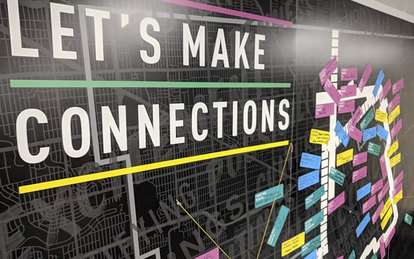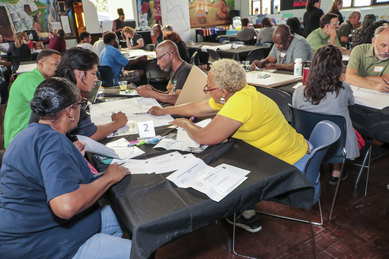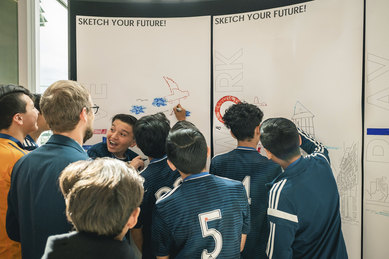Equitable Community Engagement During a Global Pandemic & Beyond

As meetings and activities shift to virtual, remote or online formats, leaders from SmithGroup's Urban Design Practice share insight for ensuring equitable representation, involvement and transparency in public engagement processes.
SmithGroup’s urban design and planning practice is built on the philosophy that equitable public engagement has the power to more inclusively shape opinion and policy, which in turn more beneficially affects the current operations and future design of our cities and neighborhoods. To ensure meaningful dialogue that leads to more equitable outcomes, our practitioners believe it is imperative to engage the broadest range of perspectives and values, and build a shared understanding of the facts and forces that shape our communities. Over the years, our teams have tried to do this in ways that meet people where they are and to use multiple methods and tools that attempt to break down barriers.
Now more than ever, our communities demand transparent engagement and decision-making processes that are sound, defensible, and inclusive. That means we need to develop methods that are thorough, enticing, sustained, nimble, and self-reflecting in order to be truly effective via both in-person and online modes, and in ways that break down rather than reinforce the digital divide in our cities. We must build trust with residents through the planning processes, and always ask, “Whose voice is missing?” to avoid bias in the engagement efforts and making sure everyone is heard.
As our cities and communities grapple with the immediate and ongoing effects of COVID-19, our methods for achieving equitable consensus in our cities must change immediately. We must develop resilient and flexible methods that continue to engage our residents in meaningful conversation beyond this current crisis. Many of the very things that have made our cities vulnerable during this pandemic have also protected us during other disasters – and made our shared lives more sustainable. As articulated in this recent New York Times article, now is not the time to give up on cities or public engagement processes, but to make them better. It is time to rapidly deploy next-generation remote collaboration tools and processes, like these, but also to not forget about some of the fundamentals that make robust engagement great.
Tools that Meet Changing Open Meeting Laws
First and foremost, public meetings must always comply with the open meeting laws established within local regulatory environments. As jurisdictions across the country are rapidly adjusting their open meeting laws to accommodate virtual meetings, it is extremely important that most of these meetings meet the following requirements:
- Do not require a sign-in to participate
- Permit two-way communication between participants and the convening board or commission
- Provide phone-in only option
- Accommodate people with disabilities (eg, closed captioning)
People-First Engagement
We feel – and our experiences have demonstrated – that the most successful engagement happens when you go to where the people are. During the current pandemic, this is no longer possible in-person, but can be successful when considering remote tools and technologies that more effectively meet people where they are:
- Utilize tools that are publicly available to maximize access
- Give people multiple opportunities and varied means/channels to contribute
- Ensure everyone has a path to engage – at their own pace
- Consider privacy when utilizing recording and monitoring
- Ensure process transparency so that people know about a meeting ahead of time, know how to get access, and know where to get more information
- Clarify ways that members of the public can identify themselves
- Provide post-meeting accountability and follow-through:
- Website postings
- Recordings and transcriptions
- Surveys
- Self-guided tours
- Letting people know that you heard them, and demonstrating how their input influenced the design or plan
Guidelines for Equitable Meetings
To authentically support a decision-making process, engagement must be conducted in a sound, unbiased manner. Engagement exercises are most successful and supportive when stakeholders and collaboration fuel the process – and where all parties can work through ideas and solutions together. As specific methods and tools continually evolve and improve, it is important to consistently consider these general guidelines for your meeting:
1. People should be able to see the faces of the people in the room
- At a minimum the core team should be visible; if possible, show everybody that's in the room
2. Conduct a health and safety check at the onset of the meeting
- Acknowledge challenges, losses and current struggles
- Give people a chance to share their status if a smaller group
3. Explain the rules of engagement:
- Acknowledge the use of potentially unfamiliar technology
- Explain what that means and what is being done to ensure everyone can participate
- Describe how the information will be used
- Let people know if the meeting will be recorded
- Inform people how they can communicate, how their communications will be addressed, and when
- Let people know rules and etiquette
- How to identify yourself
- How to mute your device
- How to pose/add a question
- How to vote
4. Conduct an ice breaker activity (especially for smaller and/or more informal meetings):
- Get people used to the technology
- Test and prove two-way communication
- Create an avatar similar to this beta version of Teooh, a startup that recently emerged from stealth
5. Answer a simple poll using Poll Everywhere, or other available tools
- A project website can also use a tool like Survey Gizmo to provide and share the results of a community survey.
6. Foster an engaging meeting:
- Make sure the presenter and presentation can be seen
- Make sure presentation is readable, even on a phone
- Allow for people to leave comments and questions in real time
- Make sure people can view what is being posted
- Assign someone the role of monitoring and helping to prioritize questions
- Incorporate interactive exercises
7. Provide a clear meeting ending and articulate next steps:
- Use a poll to get immediate feedback
- Allow the public to ask questions
- Ask participants if they feel they got an answer
- Ask participants how successful the meeting was
- Provide an option for participants to leave their contact information
- Let people know where they can find materials, and how they can continue to provide input
- Formally end the meeting so people know they can sign off
Don’t Forget to Have Fun
Lastly, engagement should always be fun and uplifting. This is even more important while communities and individuals are facing real pain, loss and challenges as part of the current crisis. Structuring engagement in ways that are clear and concise, but also playful and engaging is invaluable for getting people to think about their values and community from different perspectives. We recognize different personality types feel most comfortable engaging in different ways, and now more than ever it is important to develop a broad set of tools to make it as easy as possible to participate, whether during a pandemic or not.
Regardless of the platform, it is critical that urban designers and planners continue to meet people where they are, be great listeners, work collaboratively with clients and the community, and positively synthesize ideas, strategies, and actions that best meet the needs of today as well as the future. One of the huge challenges that we face during and after COVID-19 is a distinct digital divide in many cities: neighborhoods where many residents lack access to Wi-Fi, and mobile phones are typically the prevailing digital mode of connection.
For example, data for the city of New York indicate that 40% of residents lack either mobile or home broadband service, and 18% lack both. Many neighborhoods outside of lower Manhattan lack the infrastructure for broadband service, especially in areas of Brooklyn and Queens where there are fewer accessible conduit or utility poles. The statistics from New York are a reminder that remote technology poses its own divides, with many low-income residents lacking affordable options for internet access. In response, some cities are turning to municipally run broadband internet, with success in Chattanooga, Tennessee and others looking to replicate their efforts. Now is a crucial time to reassess how we can make remote and online engagement approaches more equitable moving forward.
We are currently living through unprecedented times in our communities. While we are all hopeful that the current COVID-19 crisis will get better sooner rather than later, we will certainly see significant changes to our cities, our communities, and our ways of life as we emerge from it. We believe that equitable and consensus-based engagement can continue to be a steadying and guiding democratic force as everything around us continues to change.

